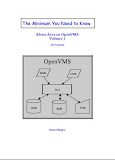The Minimum You Need to Know About Java on OpenVMS
Roland Hughes’ manual, The Minimum You Need to Know About Java on OpenVMS, is the second book that builds on his first book, The Minimum You Need to Know to be an OpenVMS Application Developer. Java is an object-oriented programming language that borrows much syntax from C and C++ but has a simpler object model and fewer low-level facilities.
In this second book, Hughes creates and demonstrates the tools you need to make Java a usable language on OpenVMS. The author delivers an in-depth guide to overcoming the problems C/C++ programmers have with Java. He notes that the problems many have with Java are rooted in syntax and where the language came from. Because the creators of Java wanted it to be a pure OOP language, Hughes explains that in Java, most things are classes. Although appearing similar in C and C++, it is not. Java has a unique class called an Array and no defined constructor. This means values can be stored anywhere and in no specific order.
In a carefully crafted and illustrated order, Hughes presents a step-by-step manual to implementing Java for more application development on OpenVMS. He points out that successfully using Java on OpenVMS requires the development of a Free Class Library. Programmers learn how to create a Class Library developed in the OOP language. As well, Hughes shows how to write Java classes using the Java Native Interface (JNI).
As in the previous book, Hughes rewrites the same application (mega-zillionaire application) with each new tool. After developing the application with Java, FMS, and RMS indexed files, he redevelops the application in this book using Java with FMS and RDB. Giving systematic and easy to follow instructions, programmers learn how to build infrastructures while at the same time building the application. Readers are shown how to develop a generic class that will be usable by Indexed Files. Hughes demonstrates how to use JNI to access RMS, FMS, system services, and operating system provided libraries. As well, programmers learn to create an infrastructure MMS Procedure and how to use the supporting classes the procedure creates. Hughes shows how to access RDB by way of the JDBC driver highlighting the importance of SQL. The CD that comes with the book contains the Full Class source.
Well-illustrated examples with detailed analysis, descriptions, and definitions, allow readers to follow the book while working with the server, thereby learning how to implement and operate Java on OpenVMS. Each chapter details troubleshooting tips, error handling tips, as well as providing exercises to enhance understanding of the tools.
With plenty of expertise, the author presents Java with all its advantages and pitfalls while often comparing it to C++. Together with easy to follow instructions, detailed examples, and an informative chapter on the future of IT, I highly recommend the book as an asset to computer programmers and those entering the IT field.
Write Field Services



0 Comments:
Post a Comment
Subscribe to Post Comments [Atom]
<< Home